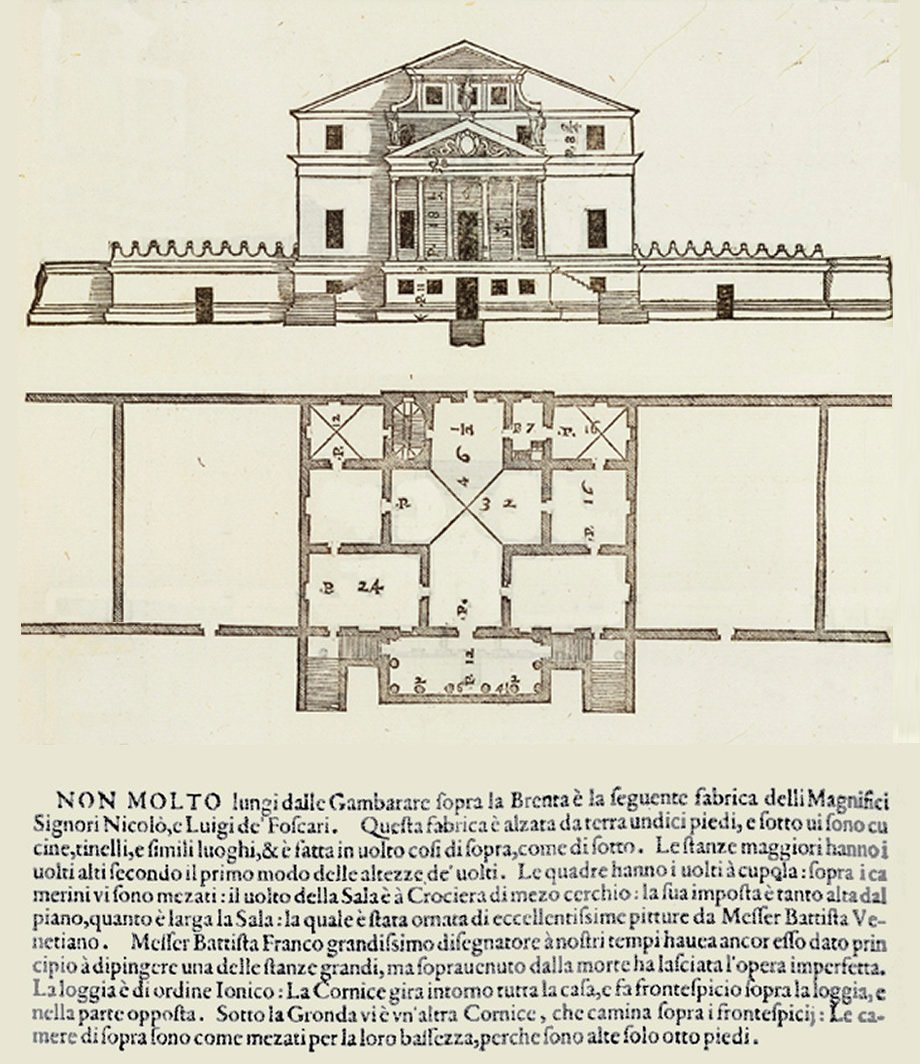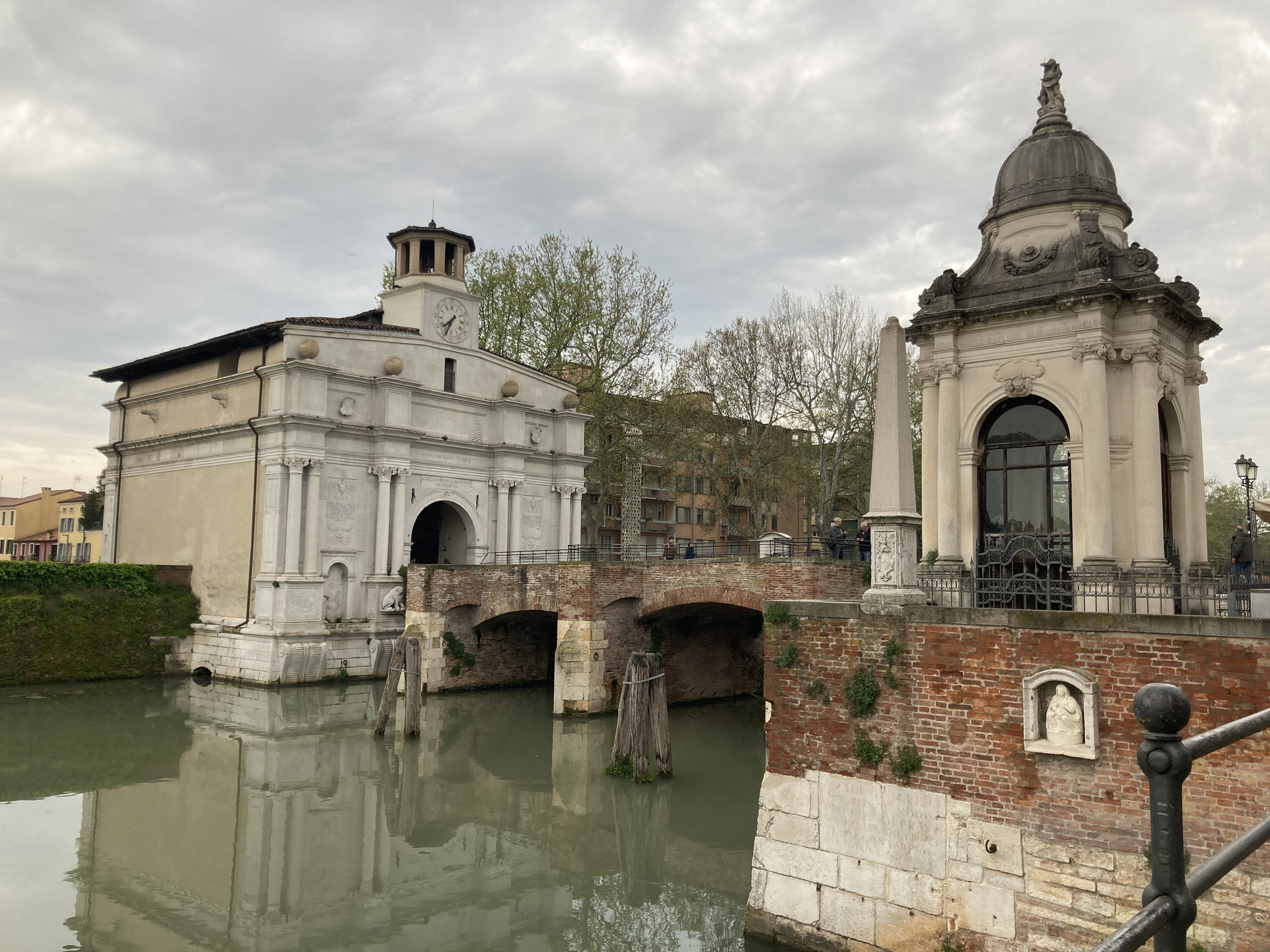Brenta Canal Part 4: Villa Foscari (Malcontenta)
The final stop on our day-long journey along the Brenta Canal was at Villa Foscari, the closest to Venice of the three villas on the itinerary.
Vintage drawing of Villa Foscari
The villa rests in an enchanting spot along the canal – with a private landing spot, wonderful views, large lawns, willow trees, and carefully tended gardens.
Villa Foscari is the oldest of the three villas visited on our one day canal cruise. It was built between 1554 and 1557 with an entirely different architectural and decorative style. Compared to the grand ballrooms and ornate details of Villas Pisani and Widmann (both built in the 1700’s), the Villa Foscari feels much more serious, more subtle, more lived in, and also a bit more mysterious.
Living room, just off the entry, Villa Foscari. Pretty cozy!
The villa was designed by Andrea Palladio and is considered one of his masterpieces. It has many typical features of Palladian design. The front facade is a symmetrical 3 stories with a grand front portico. There are classical details - massive columns, a triangular pediment, and dual external staircases all leading to the piano nobile (top photo). There are few decorative details on the exterior, also typical of Palladian architecture. The villa could easily be mistaken for an ancient Roman temple. The architecture also takes into consideration the building’s position in the landscape, so the views can be appreciated from both the front and rear of the building.
Rear facade, Villa Foscari, with an ancient wisteria vine. Less classical in design than the front facade, but still beautiful, this would have served as an entrance for the villa’s staff. It is actually the first glimpse of the villa when walking from the boat dock.
Vintage drawing of the front facade and floor plan of Villa Foscari
Palladio designed and built Villa Foscari for brothers Nicolò and Alvise Foscari. The brothers were members of the Venetian upper class and descendants of Francesco Foscari, the longest serving Venetian Doge ( he ruled Venice from 1423 to 1457). This was an important family and the villa reflects that. The interior of the villa was designed with the brother’s needs in mind - there are two symmetrical apartments, one for each brother, separated by the common space of the impressive entry.
Inside, the entry hall is expansive with vaulted ceilings, exquisite frescoes, and sunny windows flanked by perfect reading nooks looking out over the rear of the house. The other rooms on piano nobile are simply furnished but decorated with wonderful frescoes and details.
It is a spectacular yet comfortable and warm home. If I lived here, I would be hard pressed to ever tear myself away from the reading nook. A cup of tea, a good book (perhaps one of the ones written by the current owner on the history of the villa), and those views! And then maybe a walk through the gardens.
At the far side of the entry, this windowed reading nook looks out over the landscape.
The air of mystery surrounding the villa is what gives rise to its other name – The Villa Malcontenta. The legend (as recounted by our tour guide) is that one of the Foscari brothers married later in life to a very beautiful, vivacious, and young woman. As his business activities meant long stretches away from Venice, the young wife found ways to amuse herself - parties, balls, and young men! Her older husband was not pleased and so he banished her from the social whirl of Venice to his estate along the Brenta Canal where she would spend her life away from the temptations of Venice, in relative isolation. Her nickname, La Malcontenta, means the unhappy one. Today, the villa itself is often referred to as Villa Malcontenta. A sad name for such a beautiful home.
One of several gardens on the property.
looking down into one of the gardens from the front portico.
As was the case for so many of the Brenta Canal villas, the Foscari family was forced to sell the property after the fall of Venice. The estate fell into ruin in the 1800’s and stood mostly empty until restoration work began towards the end of that century. Both the villa and the gardens were restored after its purchase in 1926 by a trio of wealthy friends. After that the estate changed hands several times, always as a private home. In 1973 it was purchased by Count Antonio Foscari, returning it to the ownership of Foscari family. Antonio Foscari is both an architect and an expert on Palladian villas, the perfect person (along with his architect wife) to restore and preserve the villa. The villa remains a private home but is also open to tours. It was certainly a highlight on our one day cruise along the Brenta Canal.
The villa sits along the Brenta Canal and is surrounded by lawns, gardens, trees and wonderful views.
After visiting Villa Foscari, we headed off across the lagoon and entered Venice itself. Wandering a bit though the city we stopped for cicchetti at Cantina Do Spado and then wandered our way back to the train station. After that it was a short train ride back to our base in Padova. A perfect end to a fascinating day.
Arriving in Venice after cruising the Brenta Canal.






























